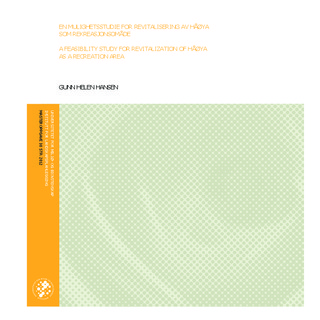| dc.description.abstract | Øyene i Oslofjorden er attraktive reisemål på varme sommerdager og har lang tradisjon som feriested for Oslos befolkning. Dette var også tilfellet for Håøya. Øya ble kjøpt av Oslo kommune på 1930-tallet, for å sikre området som rekreasjonsareal for byens befolkning. Mye har endret seg siden den gang og Håøya er ikke lenger det levende og attraktive sommersamfunnet det en gang var. Håøya sliter i dag med stort etterslep av vedlikehold og skjøtsel både på vegetasjon og infrastruktur, samt et lavt antall besøkende. Denne masteroppgaven har som hensikt å se på hvilke muligheter som ligger på Håøya og hva som kan være den framtidige bruken. Håøya er drøftet i spennet mellom bevaring og kommersialisering, for på den måten å forsøke å avdekke øyas uutnyttede potensial.Oppgaven er delt inn i fire deler. Først kommer en innledning, som forteller om bakgrunnen for oppgaven, problemstilling, oppgaveoppbygning og valg av metoder. Del én er bakgrunnsmateriale og skal gi leseren en innføring i den veksten og utviklingen som skjer i Oslo og omegn. Den gir innblikk i hvordan fjorden har vært brukt til stedssammenknytning og persontransport tidligere, og hvordan dette tilbudet er i dag. I denne delen er også begrepet friluftsliv diskutert, både i forhold til dagens behov og i et mer historisk perspektiv. Del to inneholder informantintervjuer og samtaler med fagpersoner. I tillegg til at det er utført en stedsanalyse av Håøya. Tredje og siste del inneholder selve mulighetsstudien. Her er tre ulike alternativer utviklet og drøftet opp mot hverandre. Alternativene har på hver sin måte til hensikt å hindre forvitring av verdier gjennom omtanke og utvikling. The Islands in the Oslo fjord are attractive destinations on hot summer days, and have a long tradition as resorts for the population of Oslo. This was also the case for Håøya. The island was purchased in the 1930s by the Oslo municipality to secure the area as recreational areas for locals. Much has changed since that time and Håøya is no longer the vibrant, attractive summer community it used to be. Today, Håøya is struggling with the huge backlog of maintenance and upkeep on both vegetation and infrastructure, and has a low number of visitors. This thesis aims to look at the possibilities for Håøya and what could be the future use. Håøya is discussed within the parameters of conservation and commercialization, and the tension between them, so as to uncover the island's untapped potential. The thesis is divided into four parts. The introduction lays out the background of the task, the research question, the structure of the thesis and my choice of methods. Part one is background material and should give the reader an introduction to the growth and development taking place in Oslo and surrounding areas. It explains how the fjord has been used to connect places, how transportation of passengers has been done in the past, and the current situation. In this section the term adventure is discussed in relation to current needs and also in a more historical perspective. Part two includes interviews with professionals and the people who use the island and other recreational areas along the Oslo fjord. This section also offers a site analysis of Håøya. The third part is the feasibility study. Three different options are formulated and discussed against each other. Every option is based on the intention to prevent deterioration of values, and this will be done through care and development. | no_NO |
